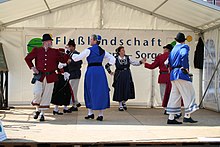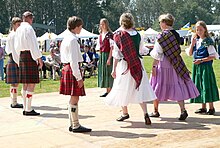Folk dance
Folk dances or folklore dances are dances that are danced at traditional folk festivals or in traditional societies. They occur in practically all cultures and form an inseparable unit together with folk music (not folk music ). In contrast to standard dances, the movements are not so strictly defined, which does not mean that they are danced completely informally.
The costume worn for dancing also differed significantly from everyday clothing in terms of jewelry , fabrics, headgear and ornaments . With the displacement of original folk music by pop music and the commercial standardization of folk festivals as well as easier access to a larger range of leisure activities, folk dances are less practiced; they are often still performed in regional groups or at special dance events such as Kathrein dance or Bal Folk as well as for tourists or at Traditional events danced.
Folk dances
In general, a distinction can be made between “real”, i.e. traditional folk dances, which have been handed down in notes and descriptions from ancient times, and so-called “folkloric dances”, which are based on modern choreography, which are often arranged with elements from ballet and a lot of theatrics include. Folkloric dance is considered to be equivalent to the folk music mentioned above.
Names of folk dances
Many dances tell a story. It is often about everyday things, such as the work of various trades, about bridal show or courtship and others. The names of the dances were derived from this (for example pottery dance , Hetlinger Bandriter , Kesselflicker (dance) , Kragelunder bridal dance ).
Other dances are named after the type of music, melody, or beat. The names of the individual dances are different from region to region and sometimes even interchangeable. Today the place of recording is often given ( Lunzer Boarisch )
Some dance names often have nothing to do with the current meaning of the word. For example, the name of Swedish, which has been handed down in Austria, is a corruption of the original name "Swabian Waltz". As with many other dance families, the Zwiefache has a wide variety of names and names that are common in different regions.
Folk dances according to origin
Dances in German-speaking countries
In December 2015, the Conference of Ministers of Education and Cultural Affairs in Germany announced that the folk dance movement would be included as cultural forms in the nationwide directory of intangible cultural heritage . On March 11, 2016, the award took place within the meaning of the Convention for the Conservation of the Intangible Cultural Heritage of UNESCO .
On March 16, 2011, the Austrian Folk Dance Movement was included in the list of intangible cultural heritage in Austria maintained by the Austrian Commission for UNESCO.
Low German folk dances
Dances from the room where Low German is spoken:
This language area includes Schleswig-Holstein , Lower Saxony , Bremen , Hamburg , Mecklenburg-Western Pomerania and parts of North Rhine-Westphalia . In addition, dances from Pomerania , West and East Prussia as well as the border regions of Thuringia and Hesse are also counted as part of the Low German folk dance .
The most common dance forms include:
- Couple dances
- Circle dances
- Tempetes
- Figaro
- Row dances
- Triplets
- Two pair dances
- Counter dances
- Quadrilles
- Bowling dances
- Six and eight pair dances
Many of these dance forms and also entire dances are also widespread in other areas of Germany and in some cases beyond the German borders.
Alpine folk dances
Some dance families from Bavaria, Austria and the other Alpine countries, each with many subspecies, are:
- Ländler or Landler
- mazurka
- polka
- Scottish
- Lathe operator
- Waltz ( German Dance )
- Twice
Further simple dances are listed on the Austrian Basic Dance page .
See also: Austrian folk dance
European folk dances
Northern European folk dances
- Schottis in Sweden, Reinlender in Norway, related to the Rhinelander
- Halling in Norway
- Pols in Norway
- Hambo (Polska) in Sweden
- Snurrebocks in Sweden
- Engelska in Sweden
- Gånglåt in Sweden
Irish-Scottish folk dances
French folk dances
Region: Alsace
- Branles
- Peasant dances
Region: North (Picardy / Flanders / Normandy)
- Flanders
Region: West (Bretagne / Vendée / Poitou-Charentes)
- An-Dro
- To Dro Retourné
- Avant-deux
- Branle
- Dañs Kef
- That's plinn
- Dañs Leon (Dañs tro)
- That's round
- (Gavotte) Fisel
- Gavotte Montagne
- Gavotte pourlet
- Hanter Dro
- Jilgodenn
- Kost ar c'hoat
- Laridée 8 temps
- limousine
- Maraîchines
- Marchoise
- Pach Pi
- Pile menu
- Quadrille de Locquenole
- Ridée 6 temps
- Rond de Landeda
- Rond de Loudeac
- Rond de St Vincent
- Trompeuse de Dinan
- Polka des allumettes
Region: Aveyron
Region: Correze
Region: Center (Berry, Bourbonnais, Morvan, Nivernais, Auvergne)
- Berry
- Bourbonnais
- Nivernais
- Morvan
- Auvergne
Region: Provence
- Brandi
- Farandole
Region: Southwest (Gascogne / Béarn)
- Rondeau en chaine
- Rondeau des Landes
- Rondeau en couple
- Rondeau à deux du Savès
- Congo du Captieux
- Congo de Luxey
- Courante de Lomagne
- Yousca a quatre
- Saut béarnais
- Branle de la Vallée d'Ossau
- Branle du Haut-Agenais
- “Sept sauts” du Bearn
Region: Basque Country
Region: Catalonia
Italian folk dances
- Saltarello
-
tarantella
- Pizzica
- Viddaneddha
- Siciliana
Spanish folk dances
Greek dances
- Ballos
- Chasaposervikos
- Chasapiko
- Sarto
- Karagouna
- Kalamatianos
- Tsamikos
- Pogonissios (Northern Greek / Albanian)
Bulgarian folk dances
- Bučimiš (Bučimiš)
- Tschetvorno
- Daychovo
- Danec
- Deninka
- Eleno mome
- Grantscharsko
- Graovsko
- Gankino
- Ginka
- Horo za pojas
- Jove malaj mome
- Kopanica (see Gankino )
- Krivo Horo
- Grandpas
- Pajduschko
- Petrunino
- Pravo Horo
- Ratschenitza
- Sborenka
- Svornato
- Tropanka
- Varnensko
- Vlaschko
Romanian folk dances
- Alunelul
- Alunelul Batut
- Briul pe opt
- Hora
- Jocul (de a lungul)
- Joc (din Patru / Aroman / de Leagane / Batranesc)
More European folk dances
- Khorovod Russian, Ukrainian, Belarusian
- Csárdás in Hungarian
- Drmeš Croatian
- Hopak Ukrainian
- Jenkka Finnish
- Kamarinskaya Russian
- Kazachok Russian or Ukrainian
- Chain dance Faroese
- Kolo (dance) Croatian, Bosniak, Serbian
- Linđo Croatian
- Lovzar Ingush, Chechen
- Mlyn (mill dance) Sorbian
- Polka Czech and all of Europe
- Rancho Portuguese
- Round dance
- Sword dance
- Trepak in Russian or Ukrainian
Folk dances from other parts of the world
Folk dances in Asia
Assyrian (also known as Aramaic or Chaldean ) folk dances
- Bagiye
- Sheikhani
- Azia Tamma
- Khigga
- Hurse
Turkish folk dances
- Halay
- Horon
- Zeybek
- Tsifteteli (Çiftetelli)
- bar
- Hora
- Lezginka
- Kolbastı
- novel
- Harmandali
- Kerimoglu
- Artvin
- Gandagan
- Oyun Havasi
- Hekimoğlu
- Cokertme
Turkmenistan
Israeli folk dances
Japanese folk dances
Afghan folk dances
African folk dances

Arab folk dances
North American folk dances
American folk dances
- line dance
- Round dance
- Square dance
- Clogging
Canadian folk dances
- Scatter promenade
- La Bastringue
South American folk dances
Mexican folk dances
- Las Chiapanecas
- Corrido
- Jesusita en Chi hua hua
- Baila
- Járabe
Brazilian folk dances
Bolivian folk dances
- Carnaval Betanceño
- Carnaval Vallegrandino
- Caporales
- Chacarera
- Cueca
- Diablada
- Huayño
- Kullawada
- Llamerada
- Macheteros
- Morenada
- Pujllay
- Saya
- Suri Sicuri
- Taquirari
- Tinku
Chilean folk dances
- Trastrasera
- Sirilla
- Resfalosa
- Chachimbo
Peruvian folk dances
- Marinera Norteña
- Cuadro criollo (Vals criollo, Marinera Limeña, La Resbalosa)
- Marinera Ayacuchana
- Tondero
- Huaylash
- Valicha
- Carnaval de Tinta
- Carnaval de Arapa
- Carnaval de Quota
- Sicuris
- Danza de tijeras
- Negrillos
- Pacasito
- Landó
- Festejo
- Zamacueca
- Alcatráz
- Movido típico
- Shapis
- Son de los diablos
- Caporales
- Selvatica / Anaconda
- Marinera Limeña
See also
- Dance terms in folk dance
- Beeraak , Dutch dance collection
literature
- Matti Goldschmidt : The Bible in Israeli Folk Dances , Viersen 2001 (191 pages), ISBN 3-933512-12-3
- Gerlinde Haid : folk dance. In: Oesterreichisches Musiklexikon . Online edition, Vienna 2002 ff., ISBN 3-7001-3077-5 ; Print edition: Volume 5, Verlag der Österreichischen Akademie der Wissenschaften, Vienna 2006, ISBN 3-7001-3067-8 .
- Herwig Milde, Belčo Stanev, The Bulgarian dance folklore . Balsies, Kiel 2004, ISBN 3-925594-58-2 .
- Gabriele Schmies: Working aid for dancing. Introduction to creative dance education . Sportjugend NRW, Duisburg 2005, ISBN 3-932047-32-X .
- Margrit Vogt: Old Low German folk dances . Coppenrath, Münster 1986, ISBN 3-88547-300-3 ( full text as PDF )
Web links
- Link catalog on folk dance at curlie.org (formerly DMOZ )
- Category: Folk dance in the Wiki Dancilla
- German Society for Folk Dance e. V. (DGV)
- French folk dances written down in the 1980s by Ulrike Frydrych & Karsten Evers. karsten-evers.de (three issues from 1982, 1983 and 1987 as PDF)
Individual evidence
- ↑ Press release of the Standing Conference
- ↑ Press release of the German UNESCO Commission , accessed on March 21, 2016
- ^ Austrian Unesco Commission




